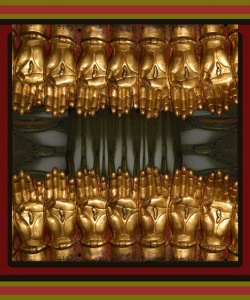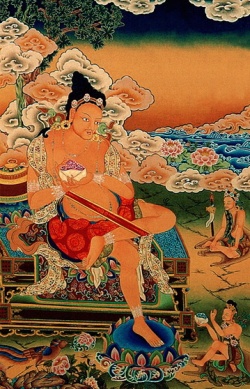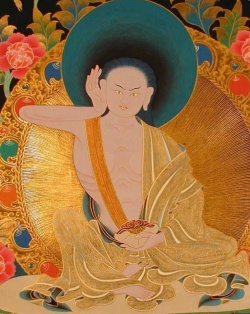Myths of the Raven
The myths and meanings of the Tower of London ravens
By Jeffrey Vallance
“If the Tower of London ravens are lost or fly away, the Crown will fall and Britain with it.”
In the summer of 2004, I was in London to give a lecture in connection with the exhibition “This much is certain” at the Royal College of Art. Previously, I had researched raven lore, heard the Tower of London raven legend, and wanted to see the Tower ravens first-hand. I came upon the portentous birds just before noon, after seeing an informative display of fake torture instruments in the Bloody Tower. The ravens were to my right, just west of the White Tower. They were gathered by their cages, situated at ground level atop a grassy mound near the ruin of the Wall of the Innermost Ward. A sign was posted: “Warning: Ravens Bite.” An ominous black raven turned my way, croaked, and then casually picked up a stick in her beak.
The Innermost Ward was an enclosed area once reserved for royalty and nobles of the court. The Ward’s crumbling 13th-century rampart wall is pierced by gaping holes that once served as embrasures (narrow slits for arrows). Purportedly, a ghostly figure has been observed glaring through the apertures in the wall – vanishing only to reappear at each hole all along the deteriorating ruin. It is behind this haunted wall that the ghastly ravens make their doleful nests.
The ravens’ favourite haunt is the Tower Green, the former site of royal beheadings. In 1536, Anne Boleyn was beheaded here. After her head was severed, the executioner held it up, and for a moment the eyes and lips continued to move. It is claimed that her bluish, headless ghost still wanders the vicinity. A gruesome shadow of a huge executioner’s axe has also been seen gliding across the Green. Traditionally, ravens are thought to be prophetic birds and are associated with execution sites and graveyards. The raven coop is placed quite close to the Bloody Tower. In 1483, the Little Princes (12-year-old King Edward V and his nine-year-old brother Richard, Duke of York) were brought to the Bloody Tower, and subsequently disappeared from history; many assume they were brutally murdered. In 1647, workmen tearing up a staircase found the bones of two children purported to be the Princes. It is said that on bleak and dreary nights, the ghostly figures of the Little Princes, dressed in white nightclothes, stand silently hand in hand before slowly fading away. At times their soft weeping can be heard after dark near the raven roost.
Sir Walter Raleigh was also imprisoned in the Bloody Tower for 13 years before he finally got the axe. His phantom has been seen floating noiselessly through the various rooms. The Beefeaters from time to time even report smelling the phantom aroma of roast beef in the White Tower after nightfall. When the Tower ghosts make their appearances, the ravens become unusually agitated and will not settle down. The 1962 MGM horror film classic The Tower of London, based on Shakespeare’s Richard III, stars Vincent Price as the demented despot haunted by grim ravens and the forlorn ghosts of his victims.
According to tradition, the curious raven prophecy can be traced back to the “Merry Monarch”, Charles II (1660-1685). On 22 June 1675, the King established the Royal Observatory at the Tower of London, housed in the north-eastern turret of the White Tower. The Royal Astronomer, John Flamsteed (1646-1719), allegedly complained to the King that the birds were interfering with his celestial observations. Charles therefore ordered their demise – only to be forewarned by an obscure soothsayer that: “if the ravens left the Tower, the White Tower would collapse and a great disaster befall the Kingdom”. There are various similar versions of the legend, but all maintain that a horrible catastrophe would be visited upon the country if all the ravens quit the Tower. After hearing the warning, the King decreed that at least six ravens be kept at the Tower at all times to prevent such a calamity. Now the birds’ wings are routinely clipped so they cannot escape.
For an example of ravens forcibly expelled from a castle tower, bringing forth a dismal curse, just look at the ill-fated Hapsburg dynasty. The Hapsburgs were rulers of the Holy Roman Empire (962-1806), and they had in their possession the miraculous Holy Lance. Long ago, the castle tower of their ancestral Schlöss Hapsburg had many ravens flying about and merrily making nests everywhere, until one day the Hapsburgs cruelly exterminated every last one of them.
This was the origin of the Hapsburg Curse. From then on, the Hapsburgs were haunted by supernatural ravens called Turnfalken, whose every appearance presaged doom to members of the imperial family. Numerous times in history the foreboding Turnfalken have been seen in Vienna soaring above the Schönbrunn and Hofburg palaces. It has been claimed that in Paris the ravens were seen hovering and screeching over Marie Antoinette as she was guillotined, in Mexico when Emperor Maximilian was shot by the firing squad, at Mayerling when Prince Rudolf and his lover Countess Maria Vetsera consummated their suicide pact (although some say they were murdered), and at Sarajevo when Archduke Ferdinand was assassinated – triggering World War I and the crumbling Hapsburg empire’s final demise.
Possibly related to the London Tower legend are other raven folktales, superstitions, and legends. According to Cornish folklore, the spirit of King Arthur is said to dwell in ravens, and for this reason it is considered unlucky and even sacrilegious to kill one. An age-old superstition states if all the ravens in a wood suddenly forsake it, surely disaster will follow. Another Tower raven legend chronicled in the Mabinogion states that upon the death of the giant king Bran the Blessed (bran means raven in Welsh), his head was cut off and buried at the “White Hill” in London, (usually identified as Tower Hill) “with the face turned towards France”. This burial is known in the Welsh Triads as one of the Three Happy Concealments of The Island of the Mighty. As long as Bran’s head stays buried there, Britain will be safe from invasion. It is as if these older legends, folktales, and superstitions fused to form the current Tower of London raven legend.
It is claimed that the ravens have been at the Tower of London since the 13th century, and for the last 400 years they have been protected by royal decree. However, Geoff Parnell, the official Tower of London historian, recently scoured records dating back a millennium and found no reference to the ravens before an 1895 article in an RSPCA journal, The Animal World. One Edith Hawthorn referred to the Tower’s pet cat being tormented by the ravens, Jenny and a nameless mate. A menagerie was kept at the Tower by generations of monarchs for at least 600 years until it became the foundation of London Zoo. There were hawks, lions, leopards, monkeys and even a polar bear – but no mention of ravens. Besides, the Duke of Wellington, who dismantled the menagerie in 1835, wanted to get dangerous animals out of the way of his garrison and would hardly have tolerated six sharp-beaked ravens hanging around. Dr Parnell’s research suggests that some ravens may have been a punning gift to the Tower by the third Earl of Dunraven (1812-71), an archæologist and antiquarian fascinated by Celtic raven myths, who added ravens to his family coat of arms. Some now believe the raven legend is a Victorian invention, but we can’t be certain. Absence of evidence isn’t evidence of absence.
Ravens are now a protected species in Britain. The Tower birds are cared for by one of the Yeoman Warders (known as Beefeaters) with the regal title of Ravenmaster. The current Ravenmaster, Derrick Coyle, a former Sergeant Major, has been at the Tower for 20 years, first serving as Deputy Ravenmaster before becoming full-time Ravenmaster six years ago. Coyle’s arms are full of nasty scars, evidence of the ravens’ powerful bills and razor-sharp talons – he stoically calls them “love taps.” The birds are fed kitchen scraps, an occasional rabbit, and the odd roadkill that the Ravenmaster happens to pick up. The ravens Odin and Thor, brothers, used to mimic the Ravenmaster’s voice, including the vocalisations, “Come on then!” and “Good morning.” Sadly, however, these two birds passed away in 2003.
It has been observed (not infrequently) that when a member of the flock perishes, the birds will hold what could be called a “raven funeral” – a 24-hour event marked by raucous outcries. The Ravenmaster buries the dead bird in the Raven Cemetery located in the drained moat close to the Watergate and the St Thomas Tower. (St Thomas is the patron saint of clergy.) There is a special Raven Memorial Headstone that lists all ravens buried there from 1956 onwards. (Incidentally, in England, tombstones are sometimes referred to as “ravenstones”.) The St Thomas Tower is also known as Traitors’ Gate because it was through this Tower that condemned prisoners accused of treason arrived from Westminster. The Tower is named in honour of Sir Thomas Becket, whose apparition has been seen striking the walls of the building with a crucifix, loudly proclaiming it was not made for the common good but “for the injury and prejudice of the Londoners, my brethren”.
As I wrote this in Southern California, a raven-black crow fell from the sky and landed dead on my driveway. I buried it in the backyard (under a spare headstone originally carved for Blinky the Friendly Hen - see FT53:23). I worried about my freshly deceased feathered friend, especially since a dead crow can indicate that the West Nile Virus is in the region. Up in Southeast Alaska, a mysterious life-threatening beak deformity is now affecting crows and ravens. The deformity can cause beaks to grow up to three times their normal size and prevent regular feeding, and in many birds it leads to death. The cause of the phenomenon is unknown.
Today the Tower strictly maintains the decree-required six ravens. Their names are, appropriately, Hugine, Munin, Bran, Branwen, Gwyllum, and Cedric. (The Norse god Odin had two raven familiars named Huginn and Muninn who perched on his shoulders and told him everything they saw and heard. I wonder if the current monarchy has the same arrangement.) Each Tower raven can be identified by a different coloured leg band. Ravens can live a long time – the oldest was Jim Crow, who died at the age 44 (and by the way, there is a bourbon whiskey called ‘Old Crow’).
To anyone from the States, the name Jim Crow sounds inappropriate as a name for a raven, as it is a derogatory term for a Black person. The era of the Jim Crow laws (the “black codes,” 1877 to the mid-1960s) is one of the most appalling and shameful periods in American history – a time of racial discrimination, segregation, and lynch mobs. The term “Jim Crow” is derived from a character in an antebellum minstrel show contrived by Thomas Dartmouth “Daddy” Rice, a white actor who was one of the first to wear blackface to do stereotypical imitations of Negro performers (paving the way for such entertainers as Al Jolson). Daddy Rice did his Jim Crow song-and-dance routine to astounding acclaim from audiences in New York and London.
During World War II, the grim raven prophecy almost came to pass, as only one raven (named Grip) was left at the Tower. The other birds were killed by bombing or pined and died of shock during the Blitz. In fact, the ravens’ cages are built on the ruined foundation of the Main Guard tower (or Queen Victoria’s Canteen), destroyed on 29 December 1940 by a Nazi incendiary bomb. In 1944, the gutted Main Guard building was demolished, revealing the mediæval Wall of the Innermost Ward. When the Tower reopened to the public on 1 January 1946, there were six ravens once again.
In 1981, a raven named Grog managed to escape from the Tower after 21 years’ service and was last spotted scavenging outside the Rose and Punchbowl pub in London’s East End. The birds are treated not as pets but as military personnel. They are “enlisted” and can be “dismissed” like soldiers for unbecoming behaviour. In 1986, a raven called George, “enlisted in 1975”, was dismissed for “conduct unsatisfactory” and sent to the Welsh Mountain Zoo. He “received his marching orders” after demolishing television aerials.
A trickster raven named Rhys, a skilful mimic, used to get behind groups of people and start barking like a dog. People would look around for the dog, while Rhys would run off, cackling to himself. Then there is the sad story of the “Two Charlies”. While preparing for a royal visit by Queen Elizabeth, a bomb-sniffing dog named Charlie was sent in. A raven also named Charlie pecked Charlie the dog, who then took the bird in his mouth and bit down hard, killing him.
According to documentation released under the Freedom of Information Act in February 2005, the Tower ravens are under threat from an invasion of 200 crows a day and these common cousins are being shot to protect the ravens from diseases and competition for food. The cull takes place before tourists arrive. The RSPB said it was legal to shoot urban crows to protect the ravens, but the law was being reviewed. However, wild ravens could soon be nesting at the Tower again after being found breeding near the capital for the first time in 180 years. Nests have been recorded in Bedfordshire, Sussex, Berkshire and Hampshire. Although once common in London, where they scavenged on refuse and the bodies hanging in gibbets at the Tower, ravens last nested in the wild in Hyde Park in 1826.
My raven research was enhanced by a pamphlet given to me by FT founding co-editor Paul Sieveking, entitled Coracomancy: Raven Crow(s) Behaviour (translated from Tibetan). According to the pamphlet, “There are expressions in the language and behaviour of ravens and crows which accurately convey messages and portents. These can be interpreted, if observed and understood correctly.” By use of coracomancy, I attempted to divine the calls and conduct of the Tower ravens I encountered. A raven crowing at mid-morning until mid-day from the west means “a long distance will be travelled”. (That was certain – I faced an exhausting 10-hour flight back to Los Angeles.) While travelling near a river (the Tower is, of course, next to the Thames), a raven crowing from the right side predicts “the journey will be successful”. (My trip did go rather well.)
A raven sitting on a castle at any time means “good lodgings will be found”. (The St Margaret hotel near the British Museum proved to be quite good. St Margaret is the patron saint of queens.) A raven holding a stick or piece of wood foretells “something will be found”. (I found a flake of the Tower that had crumbled off, and I saved it as a relic.) Concerning signs by location of nests, when a raven makes its nest in a wall, on the ground, or by water, it predicts “the King (or Queen) will prosper”. (I wondered if the Ravenmaster had read the Coracomancy pamphlet and placed the ravens’ nests on the ground near a wall – precisely in the perfect position for English Royalty to prosper.) It was the raven named Munin who gave me that piercing sideways stare with her beady jet-black eyes as she crowed “ka-ka” in a high-pitched voice, which translates as “wealth will be obtained”. (Once again the raven’s prediction was flawless, as I was subsequently notified that I would receive a major research grant.) I was amazed that the raven prognostications were all right on the money.





